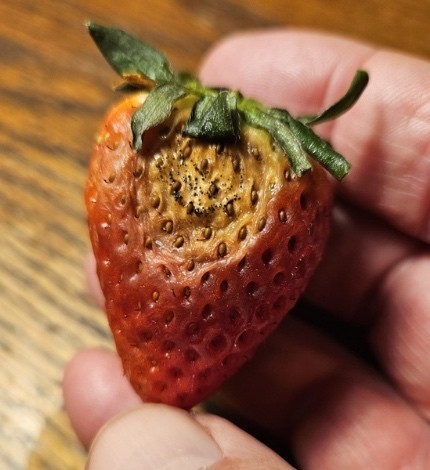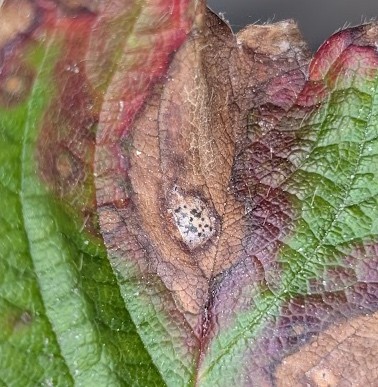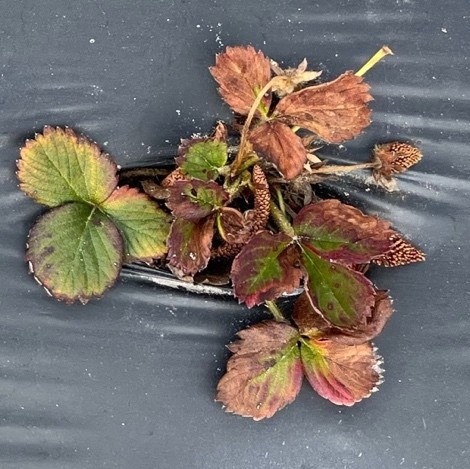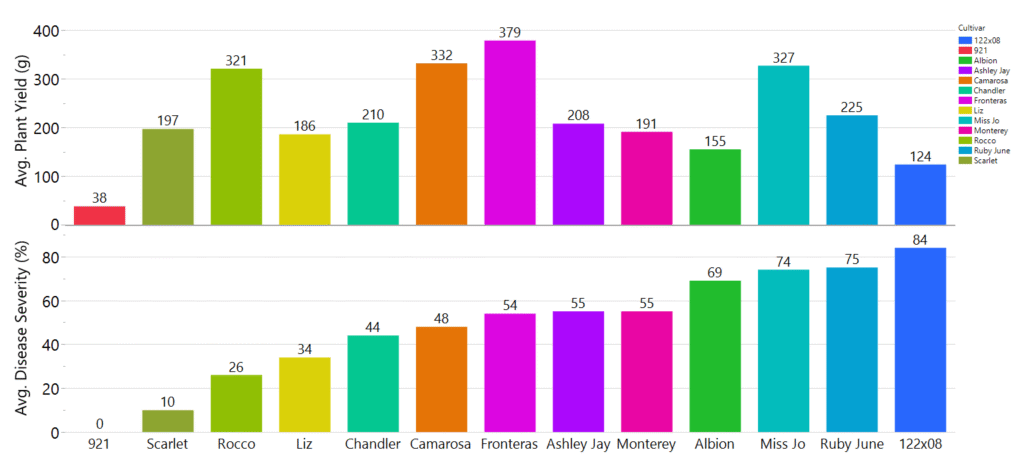Kimberly Heagy1, Caleb Bollenbacher2, Bill Cline2, John Garner3, Tika Adhikari2, and Mark Hoffmann1
1 Department of Horticultural Science, North Carolina State University
2 Department of Entomology and Plant Pathology, North Carolina State University
3 Horticultural Crops Research Station, NCDA&CS Research Stations Division
North Carolina State University (NCSU) conducted a strawberry Neopestalotiopsis (Neo-P) trial at the Horticultural Crops Research Station in Castle Hayne, NC. The main objective of the trial was to evaluate disease susceptibility and yield performance in strawberry cultivars commonly found in NC when inoculated with mixed strains of Neopestalotiopsis spp.
Neo-P leaf spot, crown rot, and fruit rot (Figure 1) is an emerging fungal disease of strawberry. Leaf spots are tan to brown, of various sizes, and often coalesce into larger, irregular shaped lesions. Fruit rot appears as shriveled, dry, light-tan lesions. Neo-P leaf spot and fruit rot symptoms can resemble those caused by other pathogens (such as anthracnose) but are distinguished by the presence of black spore masses. Crown infections are the most common symptom we see in NC, resulting in wilting, stunting, and eventual death.
Figure 1. Photos of typical symptoms of a Neopestalotiopsis spp. infection on different plant parts.



While Pestalotia-like fungi have been previously reported as minor pathogens, a large outbreak caused by Neopestalotiopsis spp. in Florida in 2018 and its reportsin other states have led to significant crop loss in the Southeastern US. While detected sporadically before, in 2024-25, NC experienced the first outbreak of Neo-P in multiple fruiting fields, with transplants being the primary infection source. The rapid spread and devastating impact of this pathogen has made it one of the main priorities for strawberry disease management.
The goal of this project is to evaluate strawberry cultivar tolerance against a mixed inoculum of Neopestalotiopsis spp. isolates collected in NC. There are currently a lot of unknowns with Neo-P, and this trial aims to shed light on some of those questions and share results back to growers.
Methods
The cultivars in this trial were Albion, Ashley Jay, Camarosa, Chandler, Fronteras, Liz, Miss Jo, Monterey, Rocco, Ruby June, Scarlet,122×08, and 921 (unreleased, Rutgers). Plants for the trial were sourced from tissue culture and propagated indoors in the propagation facility of the Plant Science Building at NCSU.
The experiment was planted in October 2024 and grown under standard annual plasticulture methods. In late March 2025, three to five plants per plot were randomly selected to be inoculated with a mixture of Neopestalotiopsis spp. isolates collected from NC strawberries. Plants were inoculated by spraying a spore suspension on whole plants with a hand pump sprayer a total of three times throughout the season. This helped to maintain high disease pressure and allowed for more obvious differences in severity between cultivars.
Plants were evaluated for marketable fruit yield and disease severity. Fruit was harvested twice a week from April 8 until May 30 and was sorted as marketable or unmarketable based on fruit size, shape and disease presence. Disease severity on inoculated plants was evaluated weekly from May 21 until June 12 and was rated based on the leaf area with spots, leaf death, and plant size when compared to uninoculated plants. Final ratings were taken after the end of the season before the field was cleared.
Results
Marketable Yield
The highest average marketable yield was 379 g produced by Fronteras (Figure 2). Other top performers include Camarosa at 332 g, Miss Jo at 327 g, and Rocco at 321 g. At the low end of performance was 921 with 38 g and 122×08 with 124 g. Cultivars that produced early in the season were Rocco, Fronteras, and Camarosa.
Disease Ratings
Disease severity differed by cultivar and severity levels increased for all cultivars over time. At the final rating (6/12/25), the cultivar with the highest average severity of 84% was 122×08; followed by Ruby June at 75%, Miss Jo at 74%, and Albion at 69% (Figure 2). Cultivar 921 showed no Neo-P symptoms, but these plants remained small and showed the lowest yield. Scarlet, Rocco and Liz also showed low disease severity with average ratings of 10%, 26%, and 34%, respectively. The common NC plasticulture cultivars Chandler and Camarosa showed middling disease severity ratings but still yielded well.
Figure 2. Average marketable yield throughout harvest in grams (above) and the final average disease severity rating from Neopestalotiopsis spp. infection (below) among common NC cultivars.

Discussion
For the overall performance of a cultivar, both the disease ratings and yield should be considered. Cultivar 921, for example, had the lowest disease severity but also yielded the least – rendering this cultivar a poor choice for NC coastal region growers. Based on disease severity and yield results, the cultivars that performed best across both metrics in this trial were Rocco, Chandler, Fronteras, and Camarosa.
In NC, many Neo-P infections often begin in the crown – leading to whole plant death. Observations from this trial reinforce the concept that clean plant material can lead to a successful season, even with Neo-P infections that begin after establishment. This was illustrated by a supplemental plot of Rocco that was grown in addition to the replicated trial (Figure 3). The Rocco plants in the replicated trial were propagated from tissue culture and considered “Neo-P free”. These plants maintained the original stand count and low disease severity. The supplemental plot, however, was sourced through outdoor nursery propagation. These plants only had a 60% stand count at the end of season and showed high disease severity due to the presence of Neo-P crown infections. The differences observed between these plots should be taken with caution, however, as the outdoor propagated material was not replicated – unlike the tissue culture plants. Further, this trial was not designed to directly compare indoor and outdoor propagated material.
Figure 3. Two plots of ‘Rocco’ strawberries showing the impact of clean plant material.


It is also important to understand these results in the larger context of managing a strawberry field. The rule genetics (G) x environment (E) x management (M) applies. For example, Ruby June showed high disease susceptibility in this trial, meaning disease management becomes more important. Managing Neo-P in a susceptible cultivar is absolutely possible but the frequency of sprays, rotation of fungicide modes of action, spray volume, and sprayer design (coverage) becomes vital.
Based on our current knowledge of Neo-P infections in strawberries, the more susceptible your cultivar is, the more important practice proper spray rotation becomes, including disease management in the fall. Fungicides such as Thiram and Switch have proven to be practical solutions to manage Neo-P in fruiting fields. With Switch’s importance for management of other pathogens in the spring, preventative sprays in the fall (until dormancy) using broad-spectrum protectant fungicides such as Thiram and Captan become extremely important for overall disease management. It is crucial to have those fungicides in stock and to maintain spray equipment. High pressure spray equipment that can reach under the foliage is an essential management tool, especially in years with high disease pressure and susceptible cultivars.
These initial results teach us more about Neo-P’s effect on different cultivars in coastal NC, but there is still more to learn about the pathogen and its habits across our state and the Southeast. NCSU will continue to research Neo-P and its relevant management practices to provide more answers to growers.